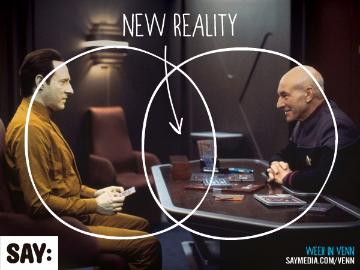The 6 Secrets of Great Tablet Content - SAY Media

The post-PC era that Steve Jobs ushered in with the introduction of the iPad is well under way. These casual, mobile, Internet-enabled devices are rapidly becoming the primary tools with which we consume our media diet. While it's tempting to slap the term "revolution" on any technological progress or new hardware release, this may well be the first time in a long time that what's happening is actually revolutionary.
Our media consumption tools — and our habits — are changing at breakneck speed. Sales of devices such as tablets and smartphones will eclipse all PC sales in 2013. While smartphones will make up for the majority of those sales, tablets are what will be replacing the PCs that we use at home — and possibly at work.
Never have we had a device that is so much about consuming content. While phones and PCs have some incredible advantages, they weren't built from the ground up for consuming content. But tablets actually were. Apparently, we've been waiting for just such a device. IDC and Forrester predict that by 2016, 375 million tablets will be sold globally, and 760 million will already be in use.
Today's high-end tablet can compete with a PC in raw power for most daily tasks and even gaming. The sacrifices being made to fit everything into a thin frame mostly go unnoticed. It's a device that you can read like a magazine and then set on a table to watch as a TV. It was familiar before it even existed. Tablets are the ultimate media consumption devices.
This revolution requires some big changes in the way we think about designing and delivering content. The following design principles are informing everything we create as we get ready for our collective tablet future:
Tablet comes first.We like to separate "tablet" from "mobile" traffic when we measure it, and this is showing some pretty interesting trends. Tablet traffic is rising rapidly, often far outpacing that of mobile phones. Readers are falling in love with tablets, and we are doubling down on making that experience more than an afterthought by designing our experiences to focus on tablets first.
Content should adapt.Every device in your life should give you a great experience. Reading an article on your iPad might be the most comfortable way to consume it but not the most practical. We want to give you the same experience whether you're at your desk, on the train or lying on the couch. Your devices may change, but your experience should maintain a level of quality across them. To help us reach that goal, we've been building the Phoenix experience platform, our own radical step toward creating a more universal interface that adapts to different devices but always feels familiar.
Context matters. The best interface is the one that gets out of the way. If we can eliminate the need for buttons and exposed interfaces, we can bring the content experience forward. We like to call these "ambient interfaces" — elements that appear contextually and content that behaves in ways you would expect it too in the real world. Orientation, velocity and touch are all being tracked by tablets, making them capable of supporting incredibly tactile, tangible experiences.
Post-resolution graphics are here. The days of downsampling hyper compressed JPEGs are over. We no longer have to accommodate old browsers or slow load times. Welcome to the era beyond high definition where pixels disappear. We won't be talking about dpi, resolution and megapixels for much longer, so we're building tools and interfaces that will help our media properties deliver post-resolution graphics on all supported devices.
Single-tasking is best.One reason why tablets work so well as content consumption devices is that they provide strictly enforced focus. Clutter on a tablet (or any touch-screen device) turns a natural, tactile experience into one that is frustrating. Information density, number of interaction points and key points of focus need to be kept in check even if the display surface is relatively large.
Welcome back to the Web. Apps have invigorated the software market. The marketplaces provide ways for content creators to monetize, which can be hard to match. Marketplace owners also are reaping rewards financially as well as by increasing lock-in. We remain focused on going Web first, building as much as we can for the last truly open platform and then looking at apps and their respective marketplaces. HTML5 offers many of the features we need to build great digital media brands, and the Web offers the quickest and most direct path to bring the content to the user. Apps remain an important part of our strategy but not at the cost of ignoring the Web experience.
Alex Schleifer is the creative director at SAY Media. Ryan Kirkman is art director and interactive designer at SAY Media.
SAY Media is a digital publishing company that creates amazing media brands. Through its technology platform and media services, SAY enables its portfolio of independent content creators to build passionate communities around key consumer interest areas such as Style, Living, Food and Tech. For more information visit www.saymedia.com.
Read all SAY Media's MediaBizBloggers commentaries at SAY Daily.
Check us out on Facebook at MediaBizBloggers.com
Follow our Twitter updates @MediaBizBlogger
The opinions and points of view expressed in this commentary are exclusively the views of the author and do not necessarily represent the views of MediaBizBloggers.com management or associated bloggers. MediaBizBloggers is an open thought leadership platform and readers may share their comments and opinions in response to all commentaries.

